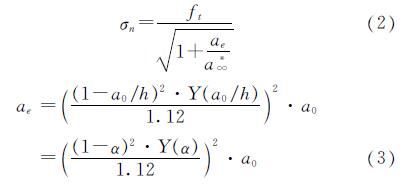基金项目:国家自然科学基金(52178259); 山东省重点研发项目(2019GSF111059)
第一作者:王俊豪(1996—),男,硕士,主要从事碱激发混凝土力学性能研究.E-mail:3037367818@qq.com 通信作者:杨树桐(1979—),男,教授,博士生导师,主要从事混凝土断裂力学研究.E-mail:shutongyang2013@163.com
(Department of Civil Engineering, College of Engineering in Ocean University of China, Shandong Qingdao 266100, China)
Alkali-activated sea sand concrete, exposed to elevated temperature, compressive strength, tensile strength, fracture parameters without size effect
DOI: 10.15986/j.1006-7930.2022.02.008
近年来,海洋强国战略成为国家发展目标之一,对沿海、近海建设以及岛礁建设愈发重视,若从内陆运输河砂及珍贵的淡水资源,不但会加大工程成本,还会造成资源的浪费.此外,硅酸盐水泥作为建筑施工中使用的重要材料,其生产过程中不仅会产生大量的尘土还会产生大量的温室气体及有毒有害气体,这会加速温室效应进一步破坏环境,也阻碍了“碳达峰、碳中和”目标的实现.有数据表明,2021年1—10月份全国规模以上水泥生产19.7亿t,同比2020年增长2.1%,其造成的污染和能源浪费不可估量[1].同时,在海洋环境下服役的建筑结构一旦遭受高温侵蚀,在这种海洋腐蚀与高温侵蚀的双重作用下,对建筑物的损害是很大的.
一种新型兼具低碳环保以及耐高温侵蚀的建筑材料——碱激发材料应运而生,相比于普通硅酸盐水泥,碱激发材料具有完全不同的水化机理,同时具有高强、高耐久性的特点[2-3].目前,国内外对于碱激发矿粉/粉煤灰混凝土高温后的力学性能的研究已在进行,研究表明碱激发矿粉/粉煤灰混凝土暴露在800 ℃环境下同样可以维持其结构稳定性,并且相比于普通硅酸盐水泥混凝土,碱激发混凝土没有高温爆裂现象[2,4-5].Li等[6]研究了碱激发矿粉海砂混凝土高温后的力学性能,发现碱激发矿粉混凝土高温后残余抗压强度明显高于普通水泥混凝土,并且碱激发混凝土与普通水泥混凝土的浆体高温后都经历了热收缩,而碱激发混凝土浆体收缩更大.
此外,混凝土在经历高温作用后,其表面会出现肉眼可见的裂缝,这就需要对高温后的混凝土进行断裂行为研究.抗拉强度ft和断裂韧度KIC是材料的两个重要的断裂参数,能体现混凝土抵抗裂缝的能力.此外,ft和KIC基于传统方法得到具有一定的随机性,因为ft基本通过轴向拉伸试验或者劈裂抗拉试验得到,得到的ft是基于材料连续性以及均匀性的假设而且其值为断裂截面的平均值[7-9].然而混凝土是一个以骨料为骨架的材料,所以它是一个不均匀的材料,其断裂参数的确定是依赖于试件尺寸的[7-9].基于此,Hu提出了边界效应模型(BEM)[10]并发现尺寸效应主要是由于断裂过程区而形成的,BEM不要求严格的试件几何相似条件,BEM考虑了材料非均匀性和非连续性并且其公式计算得到ft和KIC的方程也更加简单.无尺寸效应的断裂参数对于大构件的设计尤为关键.
对于碱激发海砂混凝土高温后的力学性能及断裂参数的预测方面的研究甚少.本文配制了两种类型碱激发海砂混凝土(AASSC),分别为粉煤灰与矿粉质量含量比1:3的Type1AASSC以及粉煤灰与矿粉质量含量比为1:1的Type2AASSC,研究其五种温度后宏观的抗压和抗拉强度、微观形貌以及预测其断裂参数ft和KIC.
试验使用的矿粉和粉煤灰分别是S95级以及C类二级灰.粉煤灰中游离氧化钙含量经检测小于4%,符合规范要求.他们的化学物质含量由仪器帕纳科Epsilon3进行X射线荧光光谱(XRF)试验测得如表1.级配良好的海砂作为细骨料,其最大粒径为5 mm.破碎的花岗岩骨料作为粗骨料,其最大粒径为10 mm.海砂细骨料和花岗岩粗骨料的基本物理参数分别展示在表2和表3.试验中使用细、粗骨料的粒径分布如图1所示.
碱激发剂为固体粉末氢氧化钠和液体水玻璃的混合物.水玻璃中含有8.3%的Na2O、26.5%的SiO2和65.2%的H2O.氢氧化钠颗粒的纯度为99%.通过向水玻璃中加入氢氧化钠将碱激发剂中SiO2与Na2O摩尔比控制为1.3.激发剂占固体粉料(粉煤灰和矿粉)质量的13%.激发剂混合好后表面封塑料薄膜静置24 h后再进行混凝土的配制.海水参考ASTM D1141-98[11]中推荐的人工海水配方配制.本文定义粉煤灰:矿粉质量比1:3的为Type1AASSC,粉煤灰:矿粉质量比1:1的为Type2AASSC.这两类AASSC的具体配合比如表4所示.
表4 AASSC的配合比(kg/m3)
Tab.4 Mix proportion of AASSC(kg/m3)
立方体抗压强度fcu试验和劈裂抗拉强度fts试验试件尺寸都为150 mm×150 mm×150 mm,参照规范GB/T50081-2019进行试验[12].常温下,对两种AASSC进行了7 d和28 d的强度试验; 在高温条件后,对两种AASSC也进行了两种强度试验.高温试验的目标温度分别为200 ℃、400 ℃、600 ℃和800 ℃,常温20 ℃作为对比组.高温试验在马弗炉中进行,马弗炉如图2所示.升温速度为10 ℃/min,到达目标温度后恒温时间为180 min,等待试件静置至室温后取出进行力学性能试验和三点弯断裂试验,加载制度也在图2中展示.所有的试件在温度20±2 ℃、相对湿度95±2%的环境下养护至28 d进行高温试验.此外,在高温试验前将试件放入干燥箱105±5 ℃烘干24 h.
三点弯断裂试验用的试件尺寸为100 mm×100 mm×515 mm,在梁底中心预制10 mm、20 mm、30 mm、40 mm、50 mm的初始裂缝,相应的缝高比为缝长/梁高=0.1~0.5.断裂试验在一台10 t的压力试验机上进行,试验加载速率为0.2 mm/min,具体的试验加载图如图3所示.使用7 t力的传感器实时监测力的数值.跨中以及两端加载支座的位移使用最大量程50 mm的位移计测量.预制裂缝处的裂缝口张开位移(CMOD)使用最大张开位移40 mm的夹式引伸计进行测量.此外,试件侧面裂缝口对称布置一对应变计来测量裂缝尖端应变,并通过加载过程中应变片的突然回缩监测裂缝的起裂状态.所有数据均由一静态数据采集仪同步采集.
图4所示折线图展示的为两种AASSC在7 d和28 d的劈裂抗拉强度变化,柱状图展示的为两种AASSC在7 d和28 d的立方体抗压强度变化.两种AASSC养护7 d后立方体抗压强度可达28 d的80%以上,劈裂抗拉强度可达28 d的70%以上.原因其一为在高OH-的浓度环境中加速了水化过程造成7 d强度上涨快[13-14]; 其二为海水海砂中丰富的海洋离子如氯离子和硫酸根离子同样可以加速水化过程[15-16].此外,Type1AASSC的两种强度在7 d和28 d下均比Type2AASSC的高.其原因为本身粉煤灰活性即比矿粉活性低,粉煤灰的作用基本为调节新拌混凝土的流动度,随着粉煤灰的掺量变大,在碱激发胶凝材料体系中同样降低混凝土强度[14].
图4 常温下7d和28d的AASSC立方体抗压强度和劈裂抗拉强度结果
Fig.4 Result of 7 d and 28 d cubic compressive strength and splitting tensile strength at 20℃
由图5可知,随着温度的升高,两种AASSC的立方体抗压强度在200 ℃和400 ℃较常温下稍有提高,Type1AASSC分别提高10%和3%左右,Type2AASSC分别提高13%和9%左右,此后高温作用导致的强度损失严重.到达800 ℃时,两种AASSC残余强度仅为常温时的14%和44%.200 ℃强度提高的原因为未水化的粉煤灰和矿粉反应生成莫来石以及在此温度下对AASSC形成内养护使得强度提高[17].600 ℃后AASSC强度急剧下降的原因为大量的化学结合水损失造成混凝土内部孔隙变多,以及高温下混凝土会发生膨胀,初始裂缝会变宽边长,膨胀引起的裂缝也会随之增多[18].800 ℃后AASSC强度损失50%以下,混凝土表面密密麻麻肉眼可见的裂缝,疏松多孔.有意思的是,矿粉含量多的Type1AASSC在20 ℃、200 ℃和400 ℃高温下抗压和抗拉强度比Type2AASSC高,原因为更多的矿粉在碱激发作用下产生更多的水化产物如C-S-H以及C-A-S-H,使得结构更为密实,但大掺量矿粉的Type1AASSC形成的此类水化产物同样造成了600 ℃和800 ℃大幅度强度的损失,原因为C-S-H和C-A-S-H对高温敏感易分解[19-21].
电镜图中红色虚线为碱激发浆体与粗骨料之间的粘结界面.从电镜图中可以看出,常温下两种AASSC的碱激发浆体与粗骨料粘结十分紧密,浆体区出现一些收缩裂缝,以及许多未水化的粉煤灰球状颗粒,而且Type2AASSC中未水化的粉煤灰球状颗粒更多,微裂缝更多,这也导致其强度低于Type1AASSC.200 ℃后,粘结界面依旧比较紧密,未水化的粉煤灰数量明显变少,说明此温度下粉煤灰在碱激发剂作用下继续发生水化反应.这解释了在此温度下AASSC抗压强度提高的原因.此外,部分微裂缝在粘结界面开展,并且裂缝宽度逐渐变大.因为自由水的损失,出现了小的孔隙区,这造成了抗拉强度的降低.400 ℃后,图中所示裂缝数量减少,这是因为高温使得浆体膨胀闭合了部分裂缝[22].一些大大小小的较大孔隙区出现,在Type2AASSC中尤为多见,这造成了浆体松散多孔.600 ℃后,随着化学结合水的损失,较大孔隙区的数量增多,并且孔隙直径在变大.Type1AASSC中已经看不到明显的裂缝,而Type2AASSC中因为其本身裂缝多,裂缝宽度也逐渐在增大.这些都造成了AASSC强度进一步降低.800 ℃后,Type1AASSC浆体疏松呈颗粒状,粘结界面十分脆弱.Type2AASSC则出现了大孔隙区与大裂隙,但相比Type1AASSC其粘结界面较为完整.这造成两类AASSC在800 ℃强度的大量损失.
传统连续介质力学计算得出的ft建立在材料是均匀的,可是混凝土材料由不同的组分组成,内部极其不均匀.尺寸效应模型被Baant提出,他提出试件的尺寸对断裂参数的确定有影响[23].从另外一个角度,一个闭环的边界效应模型(BEM)被Hu提出,当裂缝尖端远离试件的边界,断裂参数的尺寸效应基本消失[7-9].近年来,BEM模型已经在混凝土材料被多次验证其正确性[24-25].图7所示为三点弯梁当极限荷载Fmax达到时截面的应力分布,Δac为等效裂缝扩展长度,它等于一个离散系数β乘平均骨料粒径G.对于混凝土材料,本试验中使用的粗骨料最大骨料粒径为10 mm,根据理论预测模型,综合考虑粗骨料与细骨料粒径的影响,G≈dmax/1.5≈7 mm.假设在有限裂缝扩展长度的虚拟裂缝区粘结应力随着名义强度σn变化为一个常数.根据图中力的平衡关系可以得出如下关系.

式中:W为梁自重,b为梁宽,h为梁高,a0为初始裂缝长度,L为梁的跨度.
图7 当Fmax达到时截面应力分布
Fig.7 Stress distribution in the cross-section when Fmax is reached
图8 σn随ae变化曲线
Fig.8 Variation of σn with ae
图8展示的是σn随ae变化的曲线图.其中ae是等效裂缝长度,其用于描述裂缝尖端距离试件最近边界的距离.根据BEM,σn可以表示为

式中:α为缝高比等于初始缝长a0与梁高h之间的比值.对于跨高比为4的标准三点弯曲梁为

结合公式(1)和(2)可得

式中:

通过结合公式(5),断裂韧度KIC可以得到

从公式(6)和(7)可以看到,三点弯试验梁的基本尺寸信息、平均骨料粒径G、离散系数β、缝高比以及最大承载力Fmax知道后,ft和KIC都可以通过简单的公式得到求解.利用公式(6)计算得到的不同温度后的ft随初始裂缝长度a0的曲线如图9所示,KIC随a0的变化规律与ft一致,因为公式(8)所示两者成正比关系,这里就不再叙述.
图9 不同高温下ft随a0的变化
Fig.9 Variation of ft with a0 after exposure to different temperatures
如图9所示,ft基本随a0水平波动变化,这是因为混凝土材料的不均匀性导致的,即使是同情况下的五个试件,计算得出的ft也有差距.此外,这种水平波动变化也说明了这一种尺寸的试件在恒温加热180 min后,混凝土内外部达到了受热均匀的状态,否则,图中的散点不会均匀的波动变化,会出现明显的折点.
图 10所示为ft随温度的变化曲线,同样,KIC随温度变化曲线类似这里也不再赘述.从图中可以看出,两类AASSC随温度的升高,ft变化规律近似为一条负斜率的直线,在400 ℃之前,Type1AASSC的ft比Type2AASSC大,600 ℃后Type1AASSC则相对小,这与劈裂抗拉强度得出的规律一致.图中的每一个数据点为每一类AASSC五种温度、五种缝高比共25个试件ft计算结果的平均值,并且添加了代表95%保证率上下限的误差棒.表5展示了两种AASSC在不同高温温度下的ft和KIC的计算结果,可以发现基于BEM计算得到的ft明显高于相同温度下的劈裂抗拉强度fts.这是因为本文所提出的模型计算得出的抗拉强度为真实值,而劈裂抗拉试验得到的拉伸强度为破坏截面上的平均强度.
图 10 ft随温度变化曲线
Fig.10 Variation of ft with temperature
表5 ft和KIC的计算结果
Tab.5 Results of ft and KIC
本文对两种AASSC进行了五种高温温度后抗压、抗拉与断裂性能的试验研究,观察了其高温后微观界面的形貌变化,并最终基于BEM探究了该碱激发海砂混凝土高温后无尺寸效应的断裂参数的预测,得到结论如下:
(1)该AASSC具有明显的快凝早强的特点.护龄期到达7 d时,其抗压强度和劈裂抗拉强度可分别达到28 d的80%和70%.而且这种早期强度上涨的快慢与粉煤灰和矿粉掺量比没有明显关系.此外,本文两类AASSC混凝土在标准养护条件下进行养护,有研究表明,随着试件养护温度从50 ℃到90 ℃,混凝土7 d与28 d强度比从50%提高至62%[26].这说明高温养护有利于碱激发混凝土早期强度的发展;
(2)在加热至200 ℃后,两种AASSC的立方体抗压强度有一个明显的上涨,原因为未水化的矿粉和粉煤灰继续其水花反应,从SEM图中也可以看到球状颗粒未水化的粉煤灰在200 ℃高温后消失殆尽.该两种AASSC的抗拉强度变化则从200 ℃到800 ℃过程中一直逐渐降低,这是因为从SEM图中可以看到高温的作用劣化了碱激发浆体,从而使碱激发浆体与骨料之间的粘结变弱,导致了强度的降低.粉煤灰和矿粉的微观化学成分对不同高温下混凝土的宏观力学性能也有影响,矿粉较粉煤灰中含有更多的活性物质如氧化钙、二氧化硅、氧化铝,所以常温、200 ℃、400 ℃后Type1AASSC的强度高于Type2AASSC,而更好的温度对这些活性物质产生的水化产物比如C-S-H和C-A-S-H不利,所以600 ℃高温后Type2AASSC残余强度更高;
(3)对于每种AASSC,其预测到的ft和KIC随a0呈水平波动变化,即随缝高比的增加没有明显的趋势变化,这是在不同方向以及不同的试件材料的不均匀性导致的;
(4)随着高温温度的升高,每种AASSC的ft都呈现负斜率的下降,这与劈裂抗拉强度结果的规律不谋而合.并且温度越高,这种下降的程度越大因为其内部损伤的扩大.在400 ℃以下,更高GGBFS/FA质量比的碱激发海砂混凝土预测得到的断裂参数值比低GGBFS/FA质量比的混凝土高; 超过400 ℃后,前者强度损失更大并且其残余强度明显低于后者.